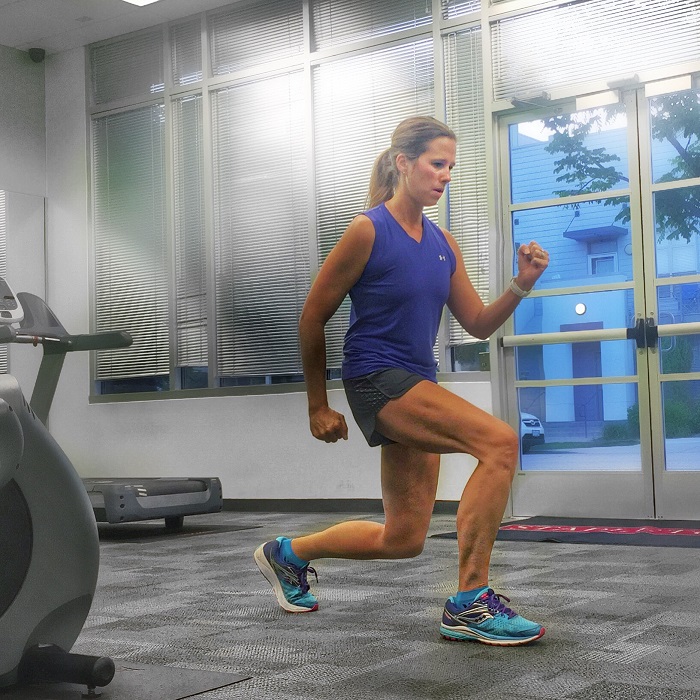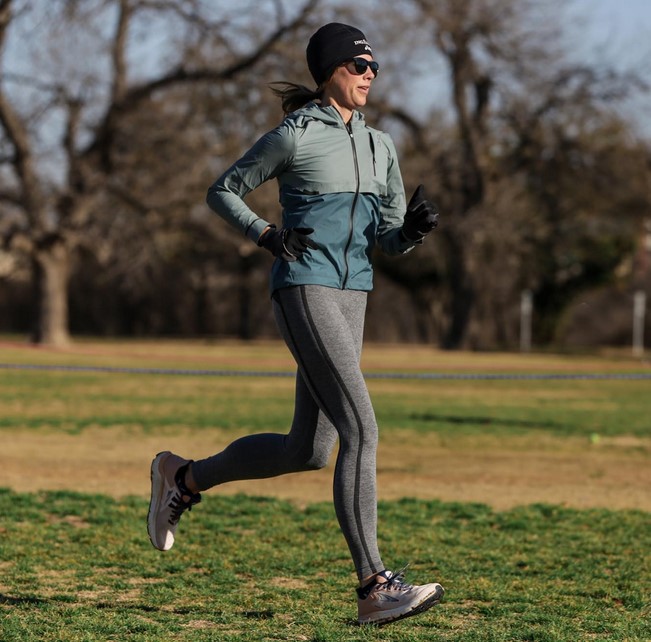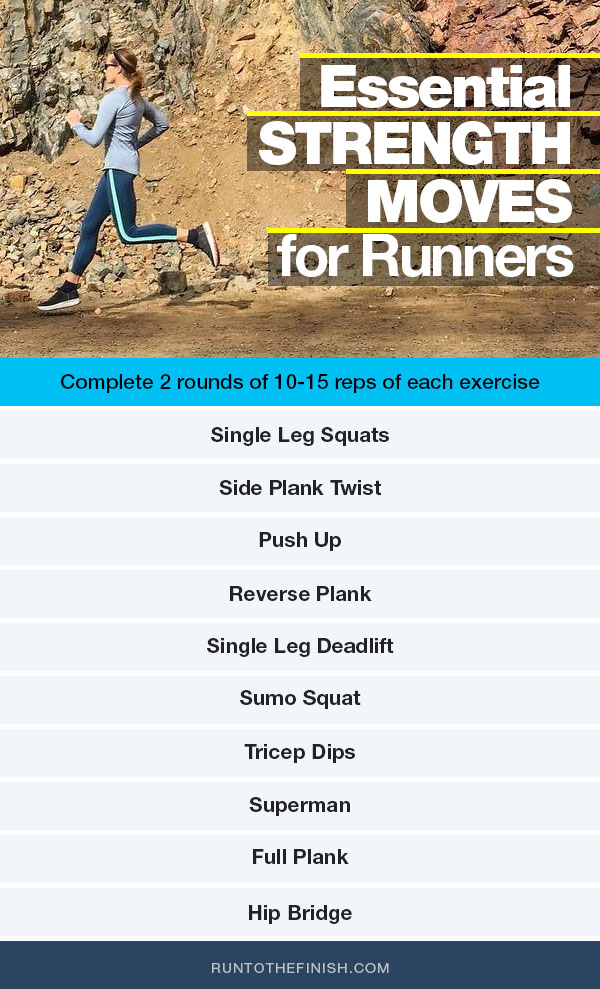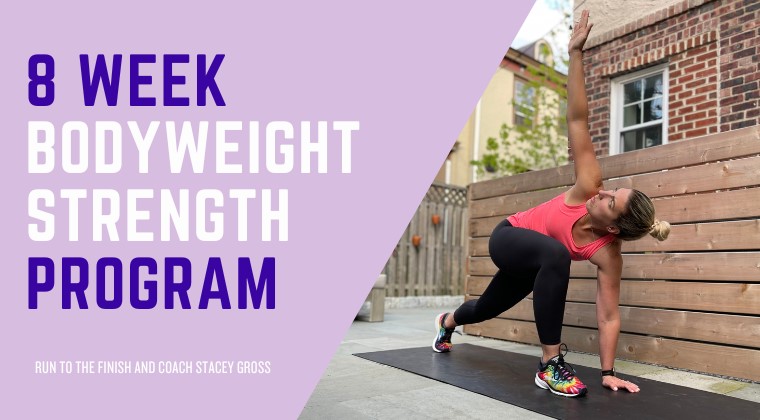As a running coach, I have witnessed firsthand the transformative power of incorporating strength exercises into a runner’s training routine. It just goes beyond simply building leg strength or improving cardiovascular endurance.
Strength exercises have the potential to revolutionize your running game, helping you reach new heights of performance, preventing injuries, and unlocking your full potential as a runner.
In this article, I will dive into why runners should prioritize strength exercises and also share some exercises and resources you can use to start an efficient strength training program today.
Why Should Runners Do Strength Exercises?
Runners should incorporate strength exercises into their training routine for many reasons. Let’s look at some of the main ones.
Enhances Running Economy
One of the key reasons why runners should embrace strength exercises is their remarkable ability to enhance running economy. By engaging in targeted resistance training, you can improve your overall efficiency, allowing you to cover more ground with less effort.
These exercises strengthen your muscles and enhance neuromuscular coordination, leading to improved muscle recruitment and synchronization during running.
The result? A smoother, more effortless stride that can make a significant difference in your performance.
Reduces Risk of Injury
Running places repetitive stress on various parts of your body, making injury prevention a top priority. Strength exercises play a crucial role in countering imbalances and weaknesses that can lead to injuries.
By focusing on strengthening your core, hips, glutes, and legs, you can improve stability and reduce the risk of common running injuries such as shin splints, IT band syndrome, and runner’s knee.
Truly, strong, well-supported muscles and joints are the basis for a healthy, injury-free running journey.

Improves Power and Speed
Strength exercises, particularly those that involve plyometrics and explosive movements, have a direct impact on your power and speed as a runner. Through specific exercises like bounding, squat jumps, and kettlebell swings, you can develop a stronger and more efficient stride.
These exercises enhance muscular power and speed, enabling you to generate more force with each step and ultimately translating into faster race times.
By incorporating strength training, you can tap into the explosive potential within you and unlock your true speed on the track or the road.
What are the Benefits of Strength Exercises for Runners?
Strength exercises have tons of benefits that can help runners become better and cross the finish line with more ease. Let’s look at some of the main benefits:
Enhances Endurance
Endurance is the backbone of every successful runner. To enhance your endurance capabilities, strength exercises are an incredibly useful addition to your current training routine.
By strengthening your muscles, you allow them to withstand the demands of long-distance running, delaying the onset of fatigue, and improving your overall endurance.
Exercises like lunges, squats, and step-ups condition your leg muscles, preparing them to handle the repetitive impact of running for extended periods. With improved endurance, you’ll find yourself conquering longer distances and pushing your limits further.
Improves Running Form
An efficient running form is essential for maximizing performance and minimizing energy wastage. Strength exercises play an important role in addressing muscular imbalances and weaknesses that can compromise your form.
A strong core and stable hips contribute to maintaining proper posture and alignment, optimizing your stride mechanics, and reducing wasted energy.
By focusing on exercises that target your core and strengthen the supporting muscles, you’ll enhance your running form and unlock greater efficiency with every stride.

Increases Strength and Resilience
To be a good runner, overall strength and resilience are incredibly important. Strength exercises not only enhance your performance but also build your resilience against external factors that can hinder your progress.
By strengthening your bones, tendons, and ligaments, you reduce the risk of stress fractures and other overuse injuries.
This strengthens your body, allowing for consistent training and faster recovery from intense workouts. With increased resilience, you can stay on track with your training plan and navigate setbacks more easily.
Improves Overall Body Composition
Strength exercises contribute to achieving a leaner physique by increasing muscle mass and improving body composition.
While running itself helps burn calories and shed excess weight, incorporating strength training can further enhance these benefits. Building muscle mass elevates your metabolism, aiding in weight management and contributing to improved athletic performance.
As a result, you’ll not only become a stronger runner, but also achieve a more sculpted and defined physique.
How to Incorporate Strength Exercises into Your Running Routine
Incorporating strength exercises into your routine doesn’t have to be difficult. Here’s how to get started:
Warm-up and Cool-down
Prioritize a dynamic warm-up routine before starting your strength exercises. This prepares your muscles for the workout ahead, increasing blood flow, and activating the key muscles involved in running.
After your workout, include static stretches during your cool-down to improve flexibility and help in recovery. Stretching helps to alleviate muscle tightness and reduce the risk of post-workout soreness.
Here’s the routine I used while in Malibu for a full body workout.
Focus on Core Strength
A strong core is one of the most important things you need for efficient running. Incorporate exercises like planks, Russian twists, and mountain climbers to target your core muscles.
By strengthening your abs, obliques, and lower back, you’ll improve stability and enhance your ability to transfer power between the upper and lower body.
A strong core helps you maintain proper posture and alignment throughout your runs, maximizing your performance potential.
I cannot emphasize this one enough. Hitting your hips, glutes and abs is one of the best ways to prevent so many common running injuries according sports physical therapists! Checkout the 30 Day Core for 10 minute follow along routines!
Engage in Functional Movements
To improve running-specific strength and stability, include exercises that mimic the movements you perform while running.
Lunges, squats, step-ups, and single-leg exercises are excellent choices. These exercises target the muscles and movement patterns involved in running, helping to build strength where it matters most.
By incorporating these functional movements into your routine, you’ll develop a stronger and more resilient body that’s perfect for running.
Don’t Forget Plyometrics
Plyometric exercises, characterized by explosive movements, are incredibly beneficial for runners. Incorporate exercises like box jumps, burpees, and skipping into your routine.
These dynamic movements develop explosive strength and power, translating directly into improved running performance. Plyometrics engage fast-twitch muscle fibers, helping you generate more force and speed with each stride.
However, it’s important to gradually introduce these exercises and ensure proper form to minimize the risk of injury.
17 Best Runner Strength Exercises (Bodyweight Exercises for Runners)
These specific strength moves for runners are designed to hit our weak areas, like glutes and hips, which lead to injuries, and our underworked areas like arms which help to power us uphill!

1. Single Leg Squats
If you’re anything like me, I don’t have the range of motion for a pistol squat. So we work on that by sitting back on to a bench with one leg extended. Initially start by placing the extended leg on the floor for support.
2. Side Plank Twist
Legs extended with both feet on the floor and forearm perpendicular to the body on the floor, place top hand behind head and then twist elbow to the ground while thinking about pulling your hips up.
Think about pressing that bottom foot in to the floor, which is going to engage the glute medius!
3. Push Up and Back
Start in a high plank position with hands slightly wider than shoulder-width apart. Complete a push up and then from the top of the push up, bend knees and push your body back like you’re going in to downward dog but with bent legs.
If you can’t yet do a full push up, then do push up with hands on a bench or counter. This will help you progress faster than knees on the ground.
4. Reverse Plank
Facing the sky, place hands below shoulders with fingers pointing towards your toes. Engage your core, press hills and palms into ground raising hips and hold up to 30 seconds with all muscles tightly contracted.
If straight leg feels too hard, you can do this from a tabletop position as well.
5. Single Leg Deadlift
This balance move is fantastic for runner’s knee!
Standing on your left leg, slowly bend at the waist, raising your right behind you and reaching hands to your shins. Do not try to touch the floor, only go to your range, then return to standing without placing down your right foot.
Remember to think about a straight back, not hunching over and your standing leg (plus core) should be working hard.
6. Sumo Squat
Did you know the lack of working your inner thighs could be part of why you get injured? With toes pointed out and legs wider than hip distance, squat down and rise up. For a bonus, squat down and then raise on to your toes to push up.
7. Tricep Dips
In a reverse table top position, hands on the floor with fingers pointing towards your feet, slowly lower down by bending and keeping elbows close to the body.
Or if you have access to a chair or bench, do this from there!
8. Superman
Laying on your stomach, contract the core and raise both arms and legs off the floor, hold for 2 and return.
9. Full Plank
No more holding planks for 2 minutes, it’s not working! Instead you need to implement the focused plank.
You should be squeezing every single muscle in your arm, core, glutes and legs to hold this plank. If you aren’t shaking by 15 seconds, you’re not squeezing hard enough.
10. Hip Bridge Marches
Lying on your back, engage the core to raise your hips and once steady begin lifting 1 leg at a time for a march. If your hips are swaying as you march, then just hold the bridge until you’re stronger.
11. Lunges
Stand with feet hip-width apart, take a big step forward with one foot and lower your body until both knees are at 90-degree angles. Push through the front heel to return to the starting position and repeat with the other leg.
If front lunges hurt, then try reverse lunges. That seems to place less stress on the knee.
12. Glute Bridges
Lie on your back with knees bent and feet flat on the floor. Push through your heels to raise your hips until your body forms a straight line from shoulders to knees. Lower back down and repeat.
There are a variety of glute bridge options and I implore you to try them all. This is one of the BEST moves we can do because glute power is everything!
13. Plank Foot Raise
Start in a push-up position, but with your forearms on the ground. Engage your core and hold the position, keeping your body in a straight line from head to toe.
Then alternate lifting one foot at a time a few inches off the ground. This is going to again force you to work on stability and engage the glutes.
14. Mountain Climbers
Start in a high plank position, then alternate bringing each knee toward your chest as if running in place. You can do this movement very slowly to really think about engaging the core. Or you can speed it up and turn it in to a cardio movement.
My preference is for you to go slow and think about what’s being worked.
15. Calf Raises
Stand with feet hip-width apart, raise your heels as high as possible, then lower them back down.
Make this harder by doing it on the stairs, so you have to let your heel lower past the stair before raising up again.
16. Bicycle Crunches
Lie on your back with hands behind your head. Lift your shoulder blades off the ground and bring your right elbow towards your left knee while extending the right leg. Repeat on the other side in a pedaling motion.
I prefer these to Russian Twists, which we now see often lead to lower back pain.
17. Step-ups
Find a sturdy step or bench, step one foot onto the elevated surface, and push through the heel to lift your body up. Lower back down and repeat with the other leg.
You can do step-ups facing forward or to the side. You can keep the leg planted on top and come up and down, or bring legs all the way back to the floor. There are a lot of options for this movement which help you to hit the legs at different angles and you should explore them all.
Should I Follow a Runner Strength Exercises Program?
If you’re looking to get serious about your fitness, strength, and running, I highly recommend looking into a well-structured training program for runner strength exercises.
Not only is it convenient but also efficient since most of the work is done for you.
But MOST IMPORTANTLY it’s going to help you progress. Plans are designed to challenge you in a slow and steady fashion, so that you can build muscle and strength without overdoing it. And of course for runners, we want to build in a way that enhances our running rather than detracting from it.
If you’re new to strength training, it’s important to start with a beginner-friendly program that focuses on fundamental movements and proper technique. This will help you establish a solid foundation and reduce the risk of injury.
On the other hand, if you’re more experienced, you may opt for a more advanced program that challenges your strength and endurance.
I recommend going with programs that are backed by running coaches and personal trainers to get the best exercises, along with really good instructions.
I’ve recently introduced the 8-week Progressive Bodyweight Strength program which includes video demonstrations for all the body weight exercises along with the perfect strength workout plan.

It’s ideal for beginners and includes challenging moves for those with more experience. It’ll help you hit all major muscle groups to help build both upper-body strength along with lower body strength. It’s ideal for distance runners and can be easily added to your current training schedule.
We have 3 other strength training programs created by run coaches and certified personal trainers, that utilize dumbbells at home or teach heavy lifting in the gym.
Looking for more training tips?
Other ways to connect with Amanda
Instagram Daily Fun: RunToTheFinish
Facebook Community Chatter: RunToTheFinish
Sign Up to Receive a Weekly Newsletter with Top Running Tips and Laughs

